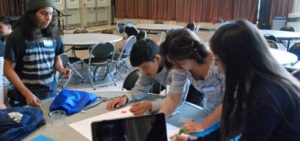Planners of Color for Social Equity host 3rd annual Youth Conference ELARA students showed growth in their return to Luskin for the Urban Planning Youth Empowerment Conference.

By Alejandra Reyes-Velarde
Luskin Student Writer
A helicopter hovered over Jesus Palalia’s neighborhood, shining the light over him as he walked home from working with his mom. He recalls the frightening experience as normal when he was younger, growing up in a ‘ghetto’ neighborhood.
Now, an 11th grade student at the East Los Angeles Renaissance Academy (ELARA), Palalia is thinking about a career in youth criminology, inspired by what he has learned through the Urban Planning Youth Empowerment Conference held by the Planners of Color for Social Equity, or PCSE, at UCLA Luskin. This is his third time attending the conference.
Palalia said that though he doesn’t think he wants to pursue urban planning as a career, he enjoys learning about it because it has exposed him to new ideas about his community. Palalia said he thinks the conference has shown him how communities and bad neighborhoods can affect youth.
“I like that I get to be creative and work with other people,” Palalia said.
ELARA is one of three high schools in the nation with a focus on urban planning and design that participate in the conference each year.
The conference aims to spark high school students’ interest in urban planning, urging them to question their surroundings and giving them the knowledge to better understand the subject. Since its first year in 2013, the conference has grown and made a stronger impact for students who now make their second and third visits to UCLA for the conference.
In a series of workshops, students now quickly write lists of residential, industrial, commercial and institutional areas on a white paper, not forgetting to include areas that serve underrepresented communities. Students write down the words ‘temporary shelters,’ and ‘community centers,’ planning where to place them on a map outlined by tape on the floor. In workshops, students independently think about the placement of each building, making sure to separate residential areas from industrial and thinking about what would serve the community the best.
Annette Moreno, a 9th grade English teacher, said she noticed students were more engaged at this year’s event.
“(In the past) students wouldn’t know what to say,” Moreno said. “Now they are really engaged and they have more experience.”
Diana Diaz, a counselor at the event, said she was surprised to learn new things about her community from the conference and the students, who discussed things such as food deserts and the pollution in their communities after the conference was over.
Edber Macedo, a first-year urban planning student and co-chair of the PCSE, and a three-year volunteer on the conference project, said he became interested in the organization because of his interactions with the students.
Though the organization aims to empower youth, Macedo said the students have been able to teach volunteers and urban planning students more about the lived experiences of the problems they try to solve.
“You forget you’re talking to high school students. They are really bright,” Macedo said, recalling his surprise as he would have conversations with the students.
When asking students what types of things they would like to see in their neighborhoods, Macedo said students responded by saying they want more green space, 24-hour fitness centers and Starbucks, giving him a different perspective about the way urban planning approaches communities.
“It’s amazing to have students from underrepresented communities to come and learn about urban planning through a critical lens,” he said.
Macedo said he also wants PSCE to aim to improve access to graduate school for underrepresented students. When he talks to the students about graduate school, Macedo said he sees they’re already concerned about not being able to afford it and not feeling like they would fit in.
“We want to demystify the college experience,” he said. “That’s why we have this conference at UCLA. To show students that in a couple of years, they can physically be here.”
Jiovani Huerta, an 11th grade student who participated, said he enjoys seeing the campus and learning about each building in terms of urban planning.
“UCLA is a great university,” Huerta said “Once you come here, you can be someone great.”
Though students have enjoyed the youth conference and have shown improvement in just three years, teachers said they want to see the program grow from being an isolated event to extending throughout the school year.
“In most cases, this doesn’t come back into the classroom,” Diaz said. “It would be good to have after-school programs or training for teachers to bring urban planning into the classroom.”

Leave a Reply
Want to join the discussion?Feel free to contribute!